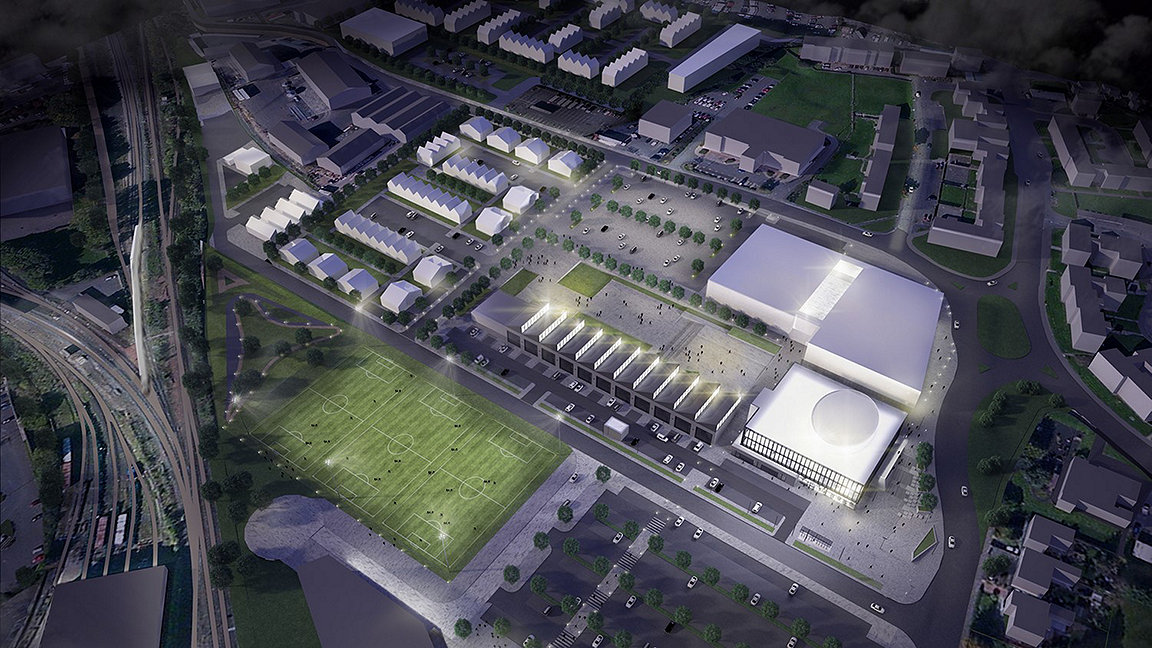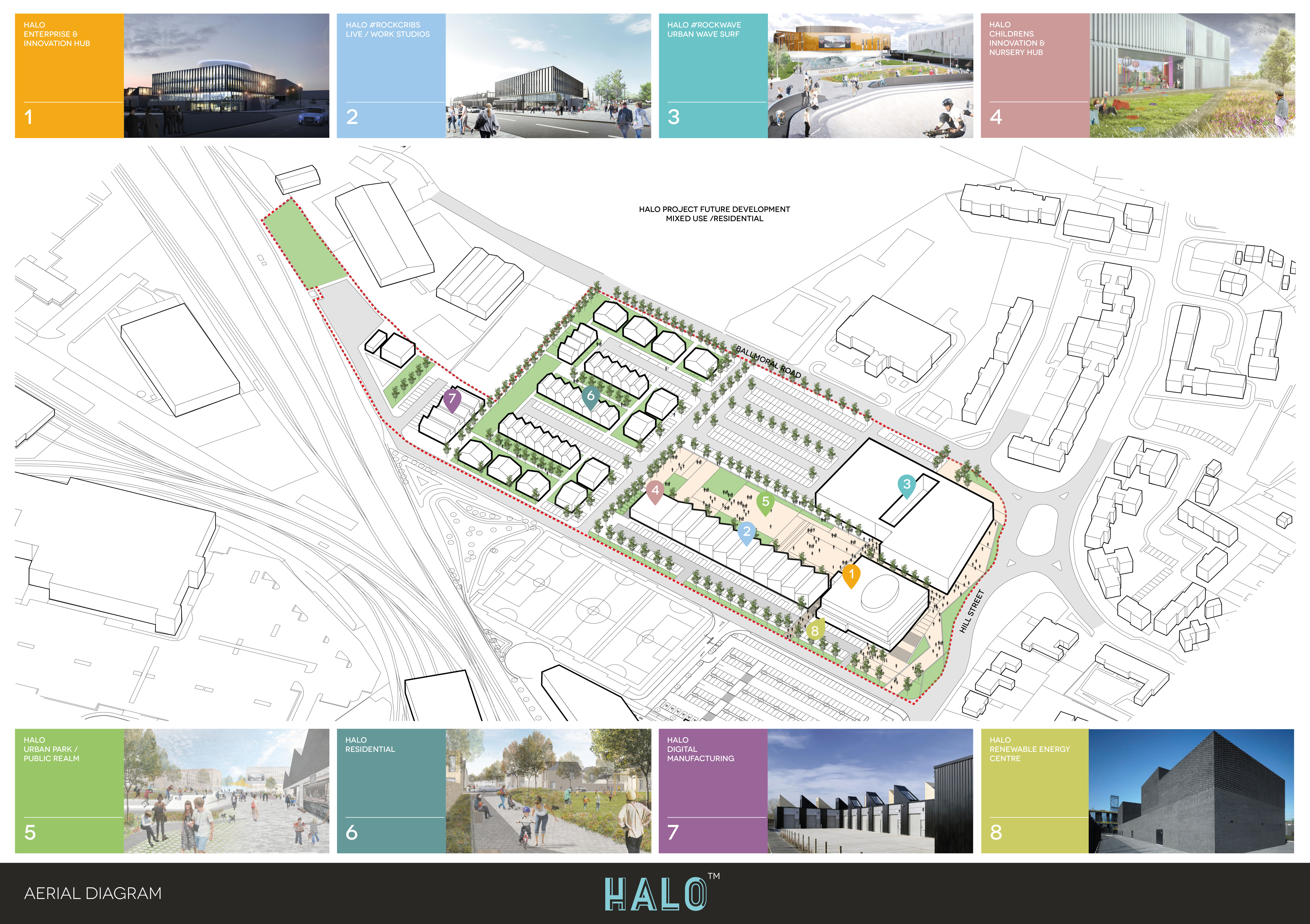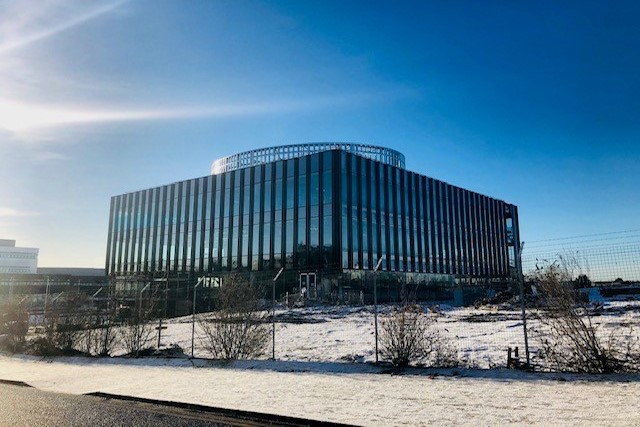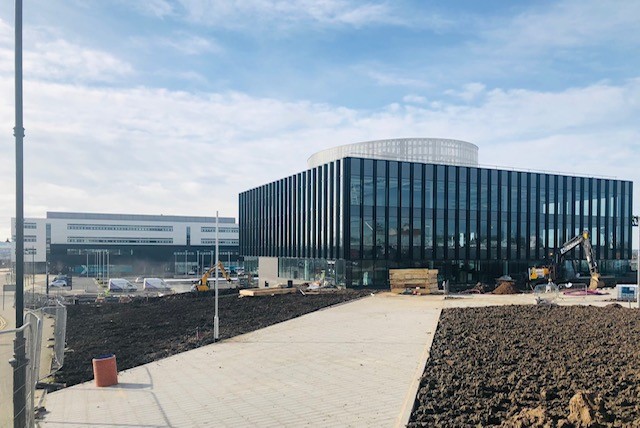
In 2009, multinational beverage producer Diageo closed its packaging plant in Kilmarnock, meaning the end of Johnnie Walker whisky’s 189-year association with its hometown. The closure left a 28-acre site vacant at the heart of the town.
Having identified an opportunity to revitalise our hometown and support the growth and resilience of the Ayrshire economy, we have spent the decade since then negotiating with the government and Diageo to come up with a masterplan for the area. The result is HALO – so-called as the halo effect is a rise from the ashes – a regeneration initiative to create a place where people can live, work, learn and play.
HALO Kilmarnock, Scotland is the first of four such town centre net zero carbon energy projects, a community urban village setting the standard for low carbon energy sites across the UK. Work on projects in the north of England, Wales and Northern Ireland is due to begin soon. The project – which focuses on minimising energy use, promoting health and encouraging enterprise – will cost £65m and will generate £200m GDP for Scotland’s economy, as well as creating up to 1,300 jobs.
The focal point of the project is the 49,500sq ft HALO Enterprise and Innovation Hub, designed to stimulate digital learning, inspire innovative thinking and support new and upcoming businesses. A Barclays Eagle Lab will be based at the HALO and the vision is to grow a new digital business economy from the venue. The Rock-Cribs studios, providing live–work space, will allow entrepreneurs to reside on site while developing their business.
- a centralised battery storage system, with solar panels across the site
- a cyber and digital training hub for young people
- a 30,000sq ft commercial hub
- HALO WAVE, a leisure complex including a surf feature built to Olympic training standards and digital retail and conference suites
- a children’s innovation and nursery hub
- an urban park and public realm, including a skateboard park
- HALO Residential SMART HOMES, designed in partnership with the Construction Scotland Innovation Centre (CSIC), comprising 210 affordable homes for rent.

Partnerships and consultation
It took 11 years of negotiations with various organisations and bodies to win support for the idea behind the project and secure appropriate funding. The site was donated for £1 by Diageo, who also provided a £2m grant. The first phase of the project is being financed with £3.5m from the Scottish government, £3.5m from the UK government, £2m from East Ayrshire Council and the remainder of the project is privately funded.
We’ve enlisted more than 50 partners, the first being Scottish Power, who approached us in 2018. We have entered into a 5-year deal worth £1m annually with the aim of creating the first net-zero carbon community urban village in Scotland while also acting as a testbed for its energy solutions. Another key partner is Barclays, who are working with us to support the local economy and create opportunity. Some partners will be able to take a glass hub in the innovation building, from which they can run their businesses and offer expert advice to growing companies in the building, where there are 110 desk spaces.
Current systems and bureaucracy mean that it wouldn’t have been financially viable for a developer to put in the effort we have over 11 years to make the scheme happen – as a developer, you wouldn’t have significant scope for profit given that public subsidies are involved. We believe instead that projects such as ours are achievable and sustainable by taking a partnership approach that puts the community at the centre.
So, while securing funding, we began the consultation process, putting the residents of Kilmarnock at the heart of it – a fundamental change from a more typical development. The first consultation saw 200 Kilmarnock residents come to a regional venue where they were split into tables of 10, given pieces of paper and asked to share what they wanted. We took away some incredible ideas from this initial consultation: some which worked, some which didn’t.
Ultimately, it became clear that the community wanted a combination of opportunities to work, learn and play, so it was then a matter of coming up with a masterplan to fulfil these, factoring in feedback and suggestions from the further five or six community consultations that followed.
"Projects such as ours are achievable and sustainable by taking a partnership approach that puts the community at the centre"

Once the masterplan was in place and fed into the design, procurement began. Contractors were required to meet the robust standards we set at tender stage, including targets based on sustainability, community values and innovative building solutions. Tenders were then evaluated by the design team and assessed against our values to produce a shortlist of contractors. Morrison Construction was eventually chosen.
Collaboration and transparency have been key to the project at all stages, and it’s vital that we keep all our stakeholders informed and engaged. As an example, East Ayrshire Council has representation on our board, while various partners sit on separate subcommittees where they work with us on the detail of what’s happening on site. Everybody involved in the site is kept aware of progress – from those that have invested to the college next door.
Although the project differs from a more traditional build, the quantity surveyors and project managers haven’t faced any fundamental difficulties in terms of their work. The main challenges have been a result of the COVID-19 pandemic; the project was halted for 14 weeks last year, and managing and monitoring the slow restart was difficult. Currently, one of the main challenges – though we’re not sure whether it’s due to COVID-19 or Brexit – is difficulties with the supply chain. This requires daily management and regular liaison with suppliers themselves.
Sustainable technology
The design and build process has concentrated on achieving environmental sustainability and durability. One of the first principles for everybody working on the project is that the site has to be as green as it can be – and that meant thinking differently and pushing the boundaries with some of the technology.
The initial commitment we made was not to use gas both for and post construction activity. Trying to get the design team to accept this from a cost point of view was a challenge at times, but it was important that everyone bought into the principle of using 100% renewable energy.
In terms of the construction process itself, we’ve ensured that the contractors have excelled against every requirement of the Considerate Construction Scheme, including managing deliveries, reducing carbon emissions from on-site fuel use, dealing with waste and selecting timber.
Using local resources as much a possible is another key measure. We’ve requested that, whenever possible, supply chains are based in the area, so the furnishing and fitting out of the project is being done by a local company, for example.
The innovation centre (see Figures 1 and 2) is powered by more than 155 roof-mounted solar photovoltaic (PV) panels, and has heat pumps installed. A carport meanwhile includes 10 parking bays with electric vehicle chargers. There will be further PV panels and electric carports for the housing, with construction on this using modular components and due to start soon. The commercial hub is being built to BREEAM excellent standard.
"The site has to be as green as it can be – and that means thinking differently and pushing the boundaries with technology"


When the project reaches occupancy stage, the aim is to monitor energy consumption and understand how individual components from carports to white goods are being used. Houses will incorporate a host of sensors that let facilities managers know when occupiers are heating particular rooms, and what the consumption rates and patterns of use are.
As an example, we will be able to identify when is the best time for people to use their washing machines based on water consumption. While carbon is, of course, a huge concern, we also need to look at how we manage and optimise the use of water. Ultimately, this will take a wholesale change in attitudes on the part of occupiers, but we believe they will see the advantages of this.
We are working with CSIC, the Digital Healthcare Institute and East Ayrshire Council’s community health department to integrate healthcare facilities into each of the homes, enabling residents to monitor their blood pressure so they needn’t go to the pharmacy or GP, for example. We have a memorandum of understanding in place with Community Pharmacy Scotland to help achieve this.
We also aim to achieve a platinum rating for the project from digital connectivity rating scheme WiredScore, to demonstrate the highest standards across the site.
Skills and the future
For those of us working on the project, every day is a school day: in doing something different and innovative, there is always an element of learning. A key part of the project, then, is sharing these lessons to develop individuals’ skills and improve future projects.
As an example, with extensive use of technology in our innovative houses and buildings comes an increased risk of cyber-attacks. We are therefore training the workforce in cyber security alongside Scottish Power’s innovation department.
As part of the educational spirit of the project, we are also re-engaging and supporting local young people. We want to create new, higher-value jobs, bringing big business back to the area along with SMEs, supporting growth, sustainability and entrepreneurship. It’s about taking corporate responsibility budget, and rather than just spending it, truly investing it to create new opportunities.
The Enterprise and Innovation Hub will bring together the knowledge, resources and national networks of the National Cyber Security Centre. We are collaborating with national and international digital and cyber specialists as well as local and national businesses, the Glasgow Caledonian University and Ayrshire College.
We’ve received £1.5m in funding from the UK government’s Kickstart Scheme, which will allow us to train 200 young people aged 16–24 in digital and cyber skills. We received almost £500,000 from the Green Economy Fund as well, to go towards measures such as an electric bus to bring young people – particularly those from economically challenged areas – for education and training. The ultimate aim is to create HALO-accredited cyber courses, some of which may be affiliated with the construction industry.
We are collaborating with Ayrshire College on a construction skills project for the residential part of the development as well, offering young people insight into the building process, techniques, approaches and technologies.
HALO Kilmarnock broke ground in October 2019, and is on track for completion by the end of April 2021. The HALO project is the people’s project, and the aspiration is then to roll it out from Kilmarnock to the three other UK projects. Projects like this need the skills of surveyors and technical professionals to succeed, but ultimately, if we are going to create change, we all need to start thinking differently and putting people and communities at the centre of it all.
"For those of us working on the project, every day is a school day: there is always an element of learning"
Supporting construction innovation
The Construction Scotland Innovation Centre (CSIC) believes projects such as HALO are key to Scotland achieving its ambitions for carbon reduction, and its own mission to foster a culture that will accelerate the transition to a net-zero built environment. The government and industry bodies have the expertise and knowledge to lead, but we need more companies like HALO to do things differently if we are to achieve our collective goals.
To meet climate change targets, we need to be building everything we can to generate the lowest possible level of emissions. Anything that isn’t as efficient as it can be will need retrofitting in future. The HALO project is open to the latest thinking in design, construction and operation, and is willing to act as a beacon for the new techniques and technologies necessary, while training the local workforce and inspiring future talent. The holistic approach to buildings and energy allows the exploration of new models for designing homes and the way we heat and power them.
- advanced manufacturing
- increased digitisation
- sustainability
- future skills.
We hope to be able to prototype aspects of the new housing development at our Innovation Factory in Hamilton – the UK’s first dedicated centre of excellence for digital manufacturing and future skill s– bringing local college students, lecturers and apprentices to learn the latest construction techniques here.
CSIC’s innovation and skills teams keep on top of developments in the sector, and our technical team is experienced in the latest digital manufacturing technology, robotics programming, timber construction techniques and the use of augmented, virtual and immersive reality. We also lean on the invaluable knowledge and practical expertise of Scotland’s academic networks and bring this into projects as far as possible.
This project is also an example of the way that digital technology is altering the roles of quantity surveyors and project managers. With the move to digital design and off-site manufacturing, quantity surveyors should become involved in the project process and design at an earlier stage. For project managers, working off site to manufacture components, modules or volumetric buildings means a move towards developing manufacturing skills and understanding processes rather than traditional construction processes.
Off-site manufacturing differs from normal contracting and required more of a focus on logistics management, haulage coordination and on-site assembly. It also demands integration of many traditional trades and a change in their sequencing.
"The holistic approach to buildings and energy allows the exploration of new models for designing homes and the way we heat and power them"
